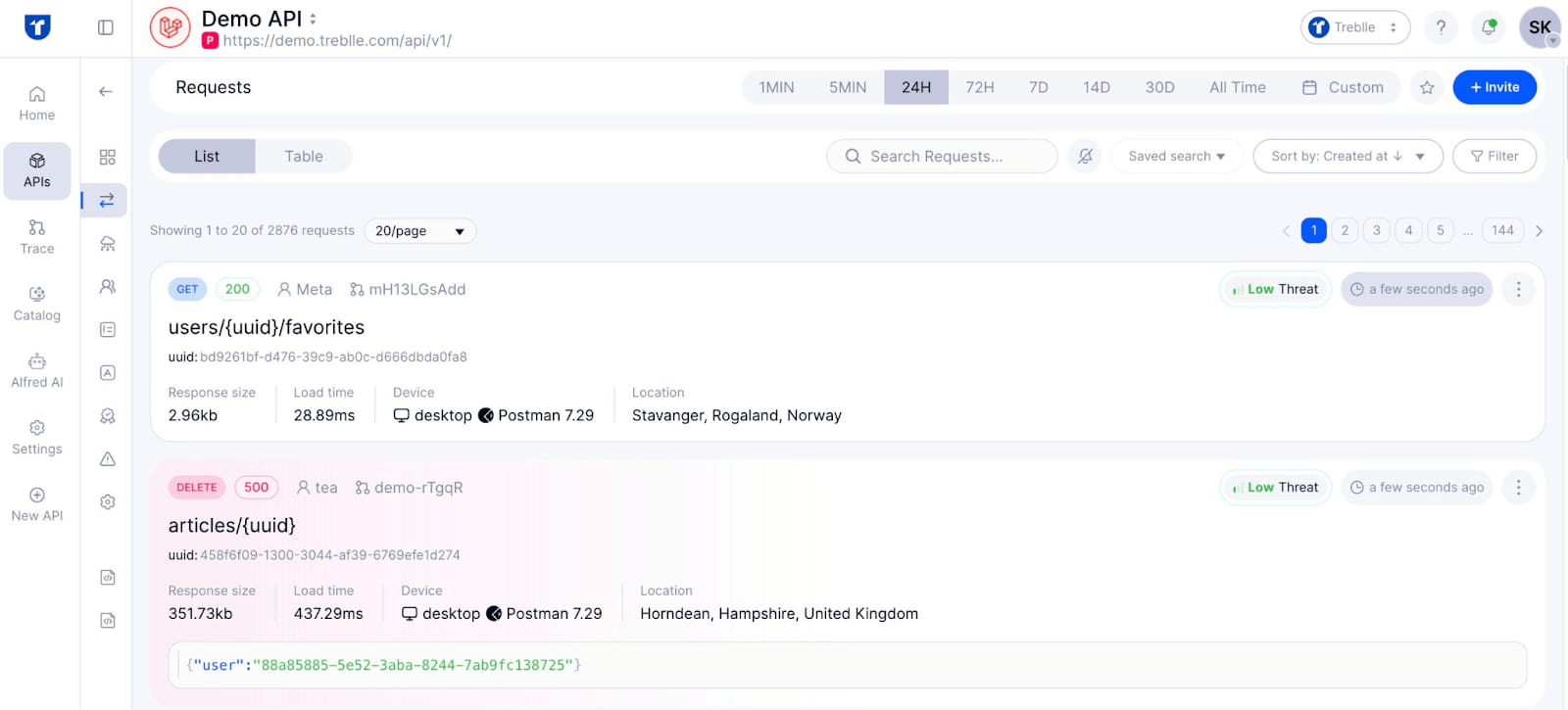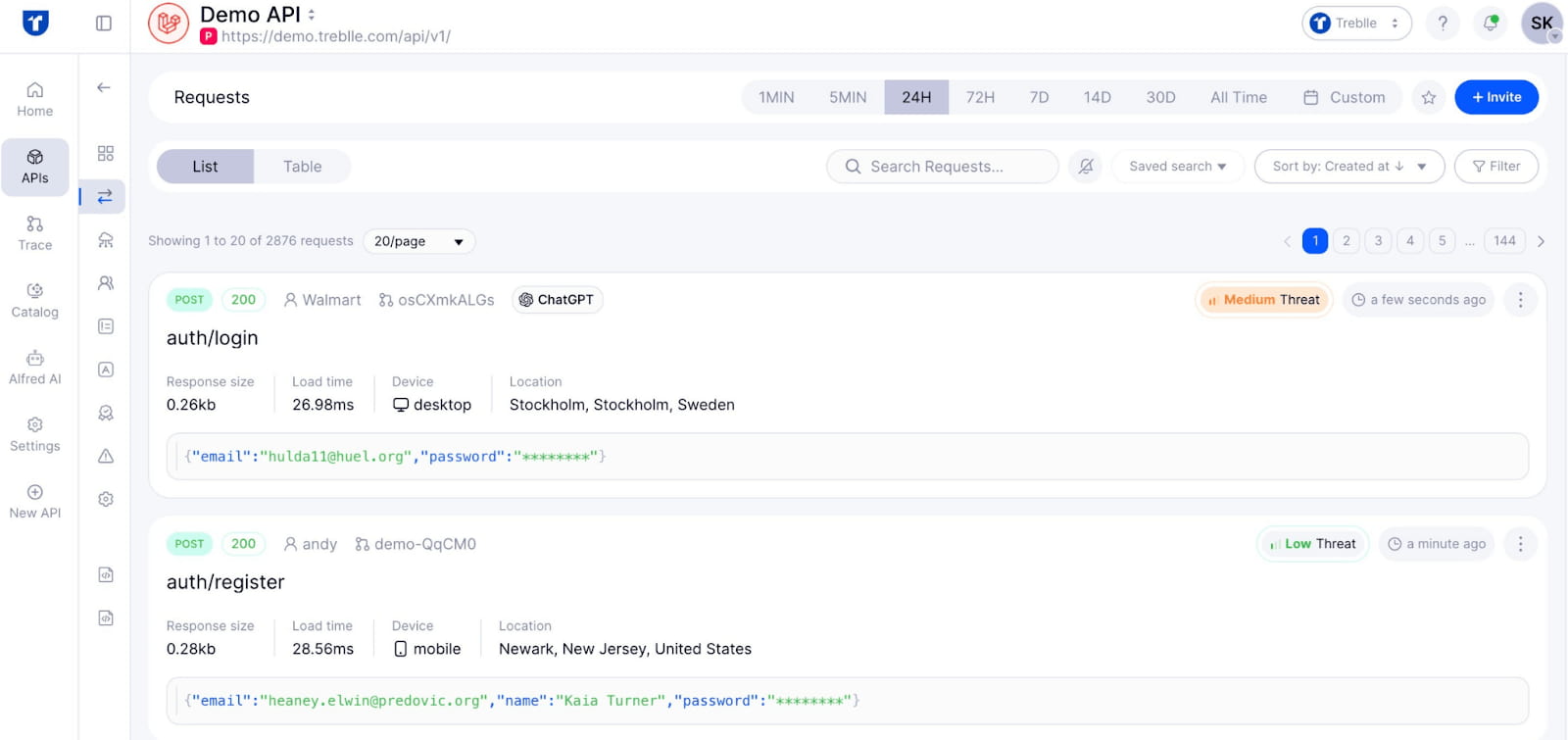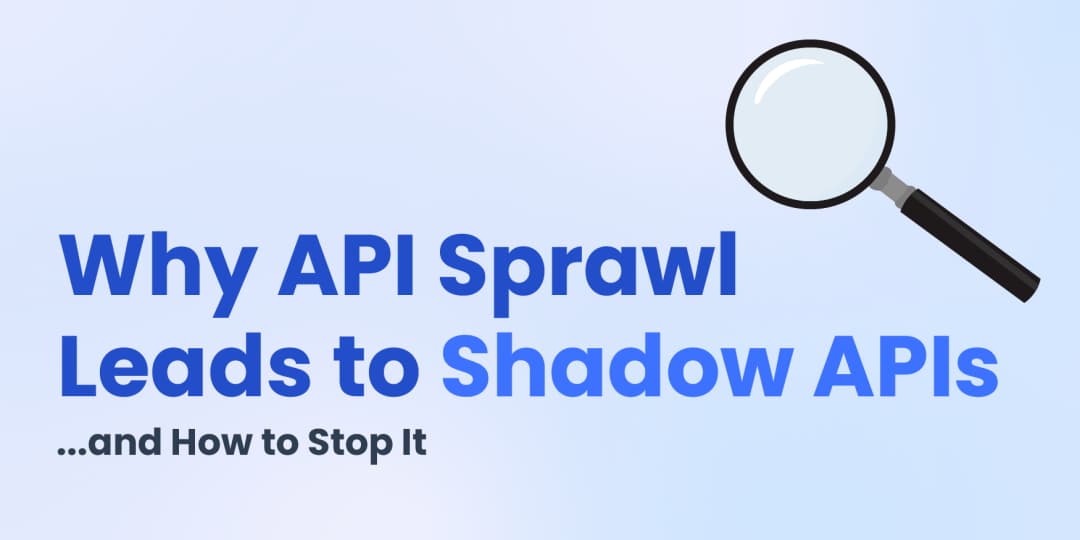API Design | Sep 19, 2025 | 8 min read | By Savan Kharod | Reviewed by David Blažević

Savan Kharod works on demand generation and content at Treblle, where he focuses on SEO, content strategy, and developer-focused marketing. With a background in engineering and a passion for digital marketing, he combines technical understanding with skills in paid advertising, email marketing, and CRM workflows to drive audience growth and engagement. He actively participates in industry webinars and community sessions to stay current with marketing trends and best practices.
API parameters are the inputs that shape an HTTP request. They filter lists, identify resources, carry metadata, and submit payloads. In practice, parameters show up in four places: query, path, headers, and body, and each has a clear job.
This guide explains when to use each, with concise examples and code. You’ll also see how Treblle surfaces query parameters, path parameters, header parameters, and request body fields automatically in one place for faster debugging and API logging.
Let’s get started.
Need real-time insight into how your APIs are used and performing?
Treblle helps you monitor, debug, and optimize every API request.
Explore Treblle
Need real-time insight into how your APIs are used and performing?
Treblle helps you monitor, debug, and optimize every API request.
Explore Treblle
Query parameters live in the URI’s query component (the part after ?) and are best used for filtering, searching, sorting, and API pagination. They refine a resource without changing its identity, for example, listing only a subset of /products. The query component is formally defined by RFC 3986 (§3.4), and clients/servers should percent-encode reserved characters per the URI rules.
Example
GET /products?category=shoes&limit=10In code (Express/Node.js)
app.get('/products', (req, res) => {
const { category, limit = '10' } = req.query; // e.g., "shoes", "10"
const pageSize = Number(limit) || 10;
const items = fetchProducts({ category, limit: pageSize }); // your data access
res.json({ items, category, limit: pageSize });
});Expected JSON
{
"items": [/* ... */],
"category": "shoes",
"limit": 10
}Notes for implementation
Prefer query params for optional inputs; keep path segments for resource identity (e.g., /users/{id}). OpenAPI explicitly models query parameters and supports array/object serialization patterns when needed.
In browser/JS code, URLSearchParams provides a clean API to read or build query strings (new URL(url).searchParams).
Treblle records the full request context, including method, URL, and query parameters, and shows them in the request detail view (with sensitive values masked). This gives you real-time visibility into exactly which filters or pagination inputs were used, alongside status, latency, and response data.

Path parameters identify a specific resource (or nested resource) as part of the URL path. In RESTful design, use path params for resource identity and reserve query params for filtering/sorting. In OpenAPI, these are modeled as in: path and typically appear as placeholders like /users/{id}.
Example
GET /users/123Here, 123 is the resource identifier embedded in the path. Per the URI spec (RFC 3986), the path is the hierarchical component that locates a resource; individual segments (like users and 123) are parsed left-to-right.
In code (Express/Node.js)
app.get('/users/:id', (req, res) => {
const { id } = req.params; // e.g., "123"
const user = getUserById(id);
if (!user) return res.status(404).json({ error: 'Not found' });
res.json(user);
});Express exposes route parameters via req.params, keyed by the :name in the route.
In code (Flask/Python)
@app.get("/users/<int:id>")
def get_user(id: int):
user = get_user_by_id(id)
return ({"error": "Not found"}, 404) if user is None else userdef get_user(id: int):Flask “variable rules” capture values from the URL and pass them to the view function (with optional converters like int).
Always use path params for identity (e.g., /orders/42), not for optional filters; keep those in the query string. Model them explicitly in your OpenAPI so clients and SDKs understand required path variables.
/users/{id} traffic and see the exact request that hit /users/123. From the Recent Requests feed, opening a request shows the full URL, method, status, timing, and request/response details in one view.
Need real-time insight into how your APIs are used and performing?
Treblle helps you monitor, debug, and optimize every API request.
Explore Treblle
Need real-time insight into how your APIs are used and performing?
Treblle helps you monitor, debug, and optimize every API request.
Explore Treblle
Header parameters carry metadata that shapes how requests are processed and how responses are interpreted. They’re not part of the URL or body; they travel alongside the message to declare formats, credentials, and client context. Key API headers include:
Content-Type — tells the server how to parse the body (e.g., application/json). The response mirrors this via Content-Type so clients know how to parse it.
Accept — lets clients state which media types they can handle; the server performs content negotiation and replies accordingly.
Authorization — carries credentials. Common schemes include Bearer (OAuth 2.0), Basic, or custom API keys. Always send over HTTPS to protect tokens in transit.
User-Agent — identifies the calling client; useful for analytics and troubleshooting.
In code (Express/Node.js)
app.post('/orders', (req, res) => {
const contentType = req.get('Content-Type'); // e.g., application/json
const accept = req.get('Accept'); // e.g., application/json
const auth = req.get('Authorization'); // e.g., Bearer <token>
const ua = req.get('User-Agent');
// validate headers, then handle request...
res.set('Content-Type', 'application/json'); // declare response type
return res.json({ ok: true, contentType, accept, ua, hasAuth: Boolean(auth) });
});Tip: Treat header validation as part of your API contract. Enforce HTTPS and verify auth headers on every API endpoint to avoid credential leakage and downgrade attacks.
Treblle captures request and response headers automatically on every call in the dashboard, allowing you to inspect Content-Type, Accept, Authorization, CORS, and custom headers per request. Sensitive values (including authorization credentials) are masked before they leave your server, preserving structure while protecting secrets; the masking list is configurable across official SDKs (and in custom SDKs) to fit your policies.

Use the request body to send structured data for create/update operations—typically with POST, PUT, or PATCH. The server decides how to parse the body based on the Content-Type header. In practice, APIs default to application/json for machine-readable payloads; web forms often use application/x-www-form-urlencoded (simple key–value pairs) or multipart/form-data (files + fields).
Example
POST /orders
Content-Type: application/json
{
"customerId": "c_7812",
"items": [
{ "sku": "A12-9", "qty": 2 },
{ "sku": "B44-1", "qty": 1 }
],
"paymentMethod": "card"
}Express (Node.js)
import express from "express";
const app = express();
app.post("/orders", express.json(), (req, res) => {
const order = createOrder(req.body); // your domain logic
res.status(201).json(order);
});express.json() parses JSON bodies and exposes them as req.body. Choose JSON for structured, language-agnostic data.
Use application/x-www-form-urlencoded for simple form key–value pairs and multipart/form-data when uploading files (or mixing files and text). Client-side, the FormData API builds a multipart/form-data body that fetch() or XHR can send.
Browser (FormData)
const fd = new FormData();
fd.append("username", "savan");
fd.append("avatar", fileInput.files[0]); // a File object
await fetch("/profile", { method: "POST", body: fd }); // multipart/form-dataFormData serializes fields/files using multipart/form-data; the server must use a multipart parser to read them.
Tips
Set Content-Type correctly (application/json, application/x-www-form-urlencoded, or multipart/form-data) so servers and clients parse bodies reliably.
Prefer JSON for API-to-API communication; use multipart only when files are involved.
Validate and size-limit bodies server-side to prevent abuse and improve error clarity. (General best practice.)
Treblle captures the full request body alongside method, URL, headers, and query/path parameters in real time—masking sensitive fields by default. In the dashboard, you’ll see the parsed body (JSON or form data), timing, status, and size, which makes debugging malformed JSON, missing fields, or upload issues straightforward. Masking is configurable per SDK.

Need real-time insight into how your APIs are used and performing?
Treblle helps you monitor, debug, and optimize every API request.
Explore Treblle
Need real-time insight into how your APIs are used and performing?
Treblle helps you monitor, debug, and optimize every API request.
Explore Treblle
Robust API logging—including query parameters, path parameters, header parameters, and request body fields—turns guesswork into diagnosis. When a call fails or behaves oddly, having the full parameter set alongside method, URL, status, and timing lets you reproduce the request, spot malformed inputs, and resolve issues quickly.
This is the essence of actionable observability and a core reason API logs exist.
It’s also a security and compliance requirement. Well-designed logs provide traceability (who did what, when) without exposing secrets. Follow OWASP guidance to avoid logging sensitive data (e.g., auth tokens, credentials) and to structure logs so incidents can be investigated.
Many regimes (e.g., PCI DSS 4.0) also mandate retention and accessibility of audit trails—plan for secure storage, access controls, and sensible retention windows.
For consistency across services, align logs with OpenTelemetry semantic conventions. Capturing standard HTTP attributes (method, target URL, status, user agent, selected headers) makes it easier to correlate parameters with traces and metrics across your stack.
Treblle automatically captures complete request context—method, URL, query/path parameters, headers, and body—and presents it in a real-time dashboard. Sensitive values are masked by default, so you see presence and structure without leaking secrets. This makes it straightforward to debug missing/incorrect parameters, auth failures, CORS issues, or rate-limit misconfigurations while maintaining a defensible audit trail.
API parameters are the contract surface of every call: query refines a resource, path identifies it, API headers carry metadata and security context, and the request body delivers structured payloads. OpenAPI formalizes this split, parameters live in query/path/header while bodies use requestBody, and URI rules (RFC 3986) define how the query component behaves, so clients and servers interpret requests consistently.
In practice, reliability comes from visibility. Log parameters alongside method, URL, status, and timing; follow OWASP guidance to avoid leaking secrets; and standardize attributes so telemetry and traces are comparable across services.
Treblle makes that operational: it captures each request’s full context, query/path parameters, headers (with masking), and bodies, inside a real-time “Recent Requests” view, so you can spot malformed inputs, auth issues, or CORS/rate-limit problems fast, without building custom logging.
If you need stricter controls, the SDKs let you customize what’s masked before data ever leaves your server.
Need real-time insight into how your APIs are used and performing?
Treblle helps you monitor, debug, and optimize every API request.
Explore Treblle
Need real-time insight into how your APIs are used and performing?
Treblle helps you monitor, debug, and optimize every API request.
Explore Treblle
 API Design
API DesignAPI authorization defines what an authenticated user or client can do inside your system. This guide explains authorization vs authentication, breaks down RBAC, ABAC, and OAuth scopes, and shows how to implement simple, reliable access control in REST APIs without cluttering your codebase.
 API Design
API DesignRate limiting sets hard caps on how many requests a client can make; throttling shapes how fast requests are processed. This guide defines both, shows when to use each, and covers best practices.
 API Design
API DesignUnmanaged API growth produces shadow endpoints you can’t secure or support. This guide explains how sprawl creates blind spots, the security and compliance risks, and a practical plan to stop it at the source.